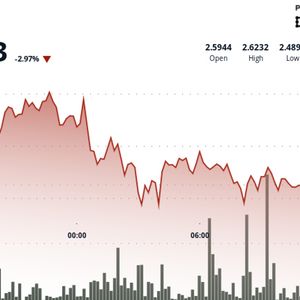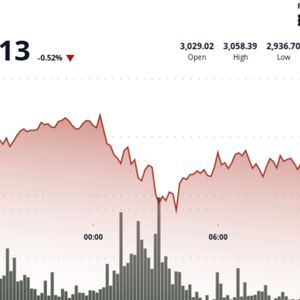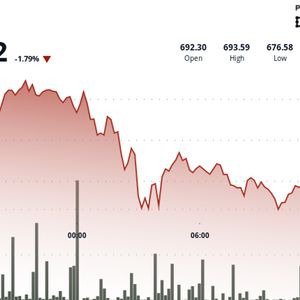CONY: Riding Coinbase’s Stablecoin-Led Upside With Dividends
7 min read
Summary The YieldMax options strategy is based on CONY’s performance being heavily tied to Coinbase. In this way, income seekers can potentially benefit from mouthwatering dividend yields. While there are risks in case Coinbase becomes volatile or spikes too fast, this thesis aims to identify an opportunity made possible by stablecoins. This opportunity is based on the crypto company’s stock appreciating gradually while being volatile. It is important to avoid a buy-and-hold strategy and monitor total returns to exit one’s position after the investment aim has been achieved. The Federal Reserve is likely to cut rates in September, and, on top of that, President Trump is urging Fed Chairman Powell to resign, potentially to be replaced by someone more dovish. This favors risky assets like equities, but one must also factor in volatility, as the market could react adversely to a sudden shift in monetary policy where inflation control is no longer a top priority. Under these conditions, this thesis aims to show that it makes sense to invest in the YieldMax COIN Option Income Strategy ETF ( CONY ), which was trading around $9.82 at the time of writing and yields above 130% as illustrated below . YieldMax’s CONY main features (seekingalpha.com) However, given the risk of NAV (net asset value) erosion faced by CONY, the investment case is based on a potential upside in the stock of Coinbase Global (NASDAQ: COIN ), on which YieldMax applies its option-based income strategy. First, for those who are new to YieldMax, whose investment objective is primarily to seek income, I provide some insights into how the strategy works. CONY Pays High Distributions, but there are risks of NAV Erosion As shown in the diagram below , CONY does not hold Coinbase as its underlying asset since it uses a synthetic covered call strategy. Instead, it uses options to generate monthly income based on the crypto platform’s stock performance. Looking deeper, YieldMax performs covered call writing on Coinbase shares, which entails selling call options and collecting premiums to fund its monthly distributions (e.g., $0.54/share on June 26). www.yieldmaxetfs.com However, the problem with such derivative-based mechanisms (in contrast to directly investing in the shares of the underlying security) is they charge relatively high fees ( 1.22% for CONY) compared to traditional dividend ETFs and, more importantly, they tend to cap the potential upside, resulting in a shortfall in capital gains when compared to an investment in Coinbase itself. Thus, this limits the ETF’s gains if the stock surges, which means growth-seeking investors may miss out on large upward movements, as in a rapidly rising market, CONY may underperform significantly compared to holding Coinbase directly. Hence, the options ETF is not meant for growth investors looking for accelerated gains, but rather for those who want to devote part of their portfolio to obtain regular income. Adding a note of caution, as seen in the chart below , dividends are neither the same every month nor do they increase gradually since these depend on the options strategy and how much gains the fund managers are willing to sacrifice to reduce NAV erosion. seekingalpha.com For YieldMax, the aim is clearly to provide maximum yields, but this cannot always be achieved, especially if Coinbase drops sustainability over a long period of time, as was the CASE from December 2024 to April 2025. Thus, CONY lost value like the stock but only managed to partially offset losses with option income since the monthly distributions were reduced (as shown in red above). This means the ETF only partially softened the blow. To this end, unlike diversified ETFs like the YieldMax Magnificent 7 Fund of Option Income ETFs ( YMAG ), CONY does not mitigate risk through broad market exposure, amplifying losses if Coinbase underperforms. Hence, in case of a prolonged downside, the problem is that this can lead to NAV erosion, and even to a point where the ETF’s shares can come close to the $1 threshold level. In such an eventuality, CONY will have to do a reverse split to avoid regulatory issues with the NYSE. Now, to avoid such a situation, which can also negatively impact investor perception, the option manager may have to moderate their aggressive income generation stance to support the share price. One example of this happening is with the YieldMax MRNA Option Income Strategy ETF ( MRNY ), which slid to the $2.25 level last month, which may be the reason for cutting dividends . Building an Investment Strategy Based on Stablecoin-led Coinbase Upside Still, viewing YieldMax’s above action from the risk mitigation perspective, it shows that the fund manager can be flexible and, depending on circumstances, adjust its strategy to limit distributions to instead prioritize capital preservation. Continuing on a positive note, I believe that CONY’s NAV could thrive even after accounting for capped upside, provided Coinbase rises steadily while volatility stays high to enable hefty call premiums. Such a situation is possible if the crypto platform operator benefits from Stablecoins, as these transform the process of sending money to other geographies, which currently involves high cross-border fees of up to 10% for international remittances. In this connection, by significantly reducing transaction costs, Stablecoins have already started disrupting incumbents’ settlement processes and have already outpaced Visa ( V ) and PayPal ( PYPL ) in terms of weekly transaction volume. Now, Coinbase’s advantage is its stake in Circle ( CRCL ), the company behind the USDC, one of the largest USD-backed Stablecoins. In addition, by allowing users to trade (buy and sell) USDC on the Ethereum network through its wallet services, Coinbase supports Stablecoins on its platform. Furthermore, as part of the priorities for 2025, the CEO, Brian Armstrong, outlined plans to grow sales and accelerate USDC’s market cap through partnerships and new use cases like payments. This is in addition to generating revenues by expanding existing products and carrying out more trading and derivatives activities. Looking further, the management’s confidence was also due to a favorable regulatory environment. In this connection, the U.S. Treasury Secretary announced a new Stablecoin bill called the GENIUS Act , which passed the Senate in mid-June and has moved to the House of Representatives for further consideration. If passed, this can potentially expand the Stablecoin market from $150 billion to $2 trillion in the coming years, possibly by 2028 . For investors, Stablecoins are like digital dollars. The difference with the USD is that they are issued by private companies rather than banks, but backed by the greenback. Moreover, use of Stablecoin for mainstream commercial activities presents a significant revenue growth opportunity for Coinbase, as by lowering costs, it can potentially attract individuals and small-to-medium businesses seeking alternatives to traditional payment networks. On top, Coinbase can leverage its partnerships with PayPal and Shopify (SHOP) to expand its ecosystem and take advantage of regulatory advantages to boost its revenue share by creating additional fee streams from Stablecoin transactions. Now, if the stock rises sustainably due to Stablecoin-related growth, CONY benefits from capital appreciation thanks to Coinbase’s momentum, despite the capped upside. The reason is that for CONY to appreciate sustainably, Coinbase stock needs to trend upward gradually (in contrast to spiking sharply) while maintaining elevated volatility to yield juicy premiums. In this way, CONY’s strategy can work optimally in the sense that, in addition to generating premium income from selling calls, its share price can rise to benefit from a net appreciation as Coinbase rises steadily while staying below the call strike price. CONY Could Appreciate While Paying Dividends, but Avoid Buy-and-Hold Because of Risks Looking at the probability of the above scenario materializing, this appears feasible given that, after Coinbase’s meteoric rise, mostly by its financial performance (revenue surging by 115% for the financial year 2024), the future growth trajectory appears more measured. Hence, revenues are likely to increase by only 12.5% during this year, according to analysts’ estimates. Along the same lines, Coinbase’s Stablecoin-related sales, consisting mostly of fees, should be more of a recurring nature, unlike trading revenue, which tends to be cyclical. This could help Coinbase’s stock grind higher steadily as USDC adoption grows in the 2025 to 2028 period. Such a slow and steady rise is ideal for CONY’s covered call strategy and is in sharp contrast to the wild swings (including sharp upsides) seen during the crypto bull run. Now, an upside is also supported by momentum indicators since the price is above the 10-day, 50-day, and 100-day moving averages. Thus, CONY may rise from $9.82 per share to its 200-day moving average of $11.42, or roughly by 16%. However, due to the structure of the ETF, which is not designed to benefit fully from Coinbase’s rallies and instead captures only a portion of the underlying security’s increase in value, an upside can take considerable time. Also, as per my observation, during past COIN rallies where it jumped by 15–20%, CONY rose by around 2–5%, or a ratio of about five, as shown below . seekingalpha.com Therefore, suppose Coinbase rises by 80% during the next three years, CONY could rise by 16%, which is not much, but, first, one has to consider that it is designed for yield (not price appreciation). Second, the share price moving up reduces the probability of an investor suffering from an NAV loss on his or her initial investment. Noteworthily, one should avoid a buy-and-hold strategy with CONY and instead monitor the performance and exit as soon as the investment objective (like percentage gains) has been attained. For this purpose, it is better to look at the total return, which includes price return and dividends in case these are reinvested, instead of just price appreciation. Data by YCharts In conclusion, CONY is appropriate based on a scenario where Coinbase rises gradually and for those prioritizing income over price appreciation amid volatility. The option strategy is also suitable for those owning shares of the Stablecoin services provider and wanting further exposure, but with dividends and some downside cushion. Still, CONY’s performance is heavily tied to Coinbase, making it vulnerable to its financial performance in addition to regulatory delays in case the GENIUS Act faces hurdles in the House and the crypto market faces volatility since its business is also tied to crypto trading. Also, there are risks of Coinbase spiking too fast due to hyper-growth in USDC, causing CONY’s calls to get exercised prematurely, capping gains. This means that for those desiring to capture upside from a Coinbase rally, buying the stock directly or opting for a leveraged ETF like the GraniteShares 2x Long COIN Daily ETF ( CONL ) is more appropriate.

Source: Seeking Alpha



